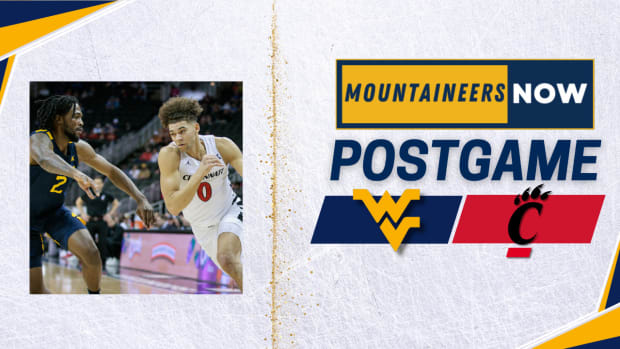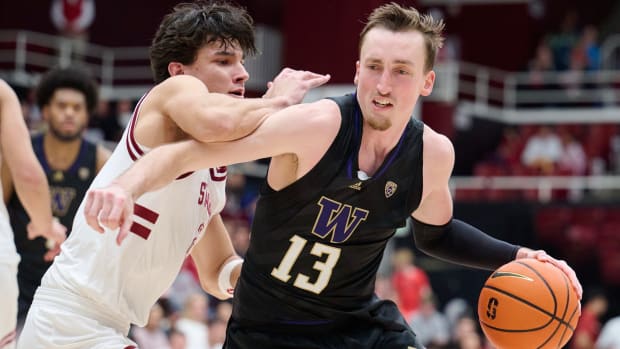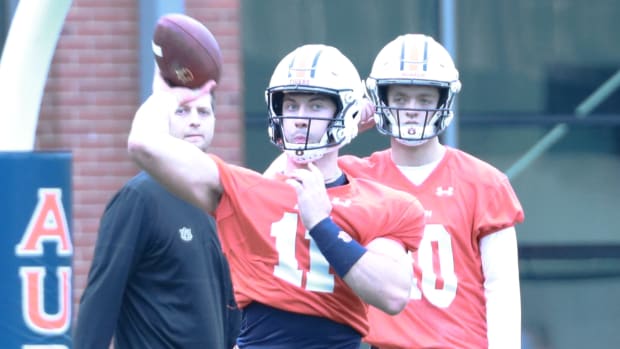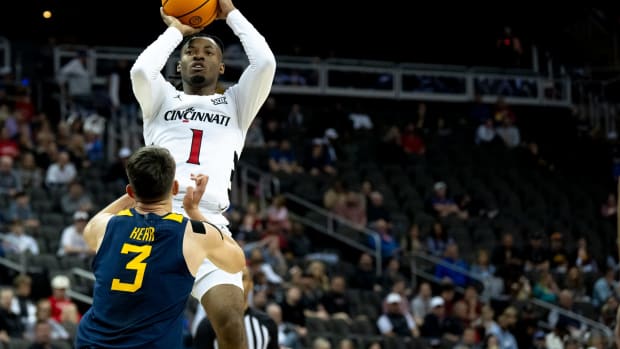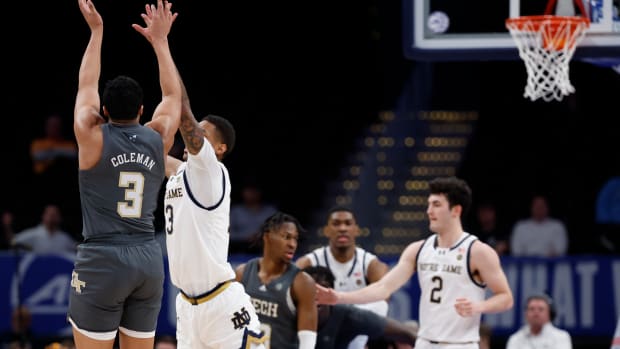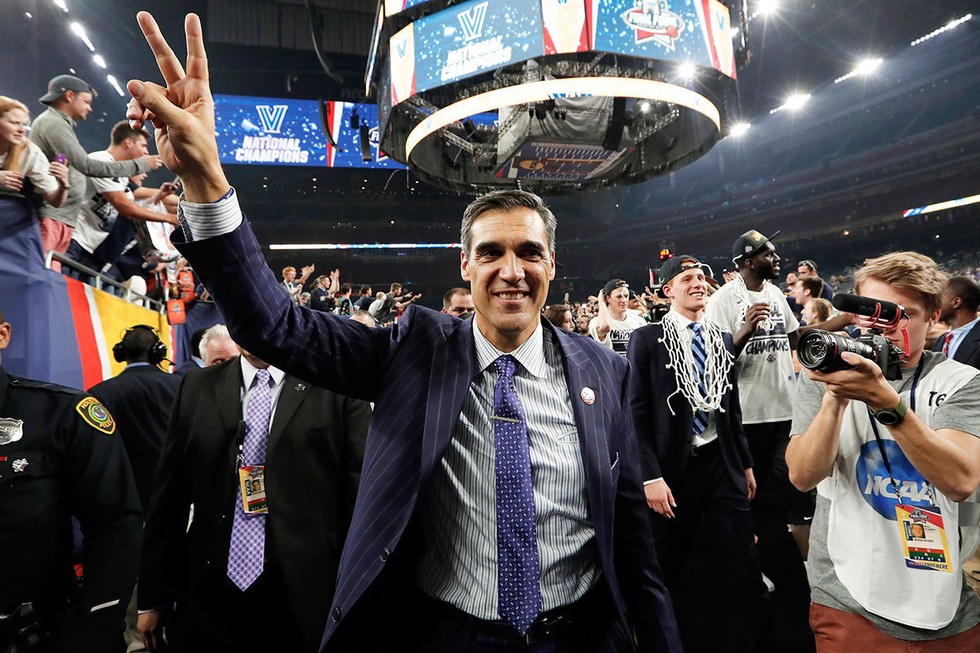
Hoop Thoughts: Ten storylines to watch as the 2016–17 season tips off
[video: 13724736]
It is quite fitting that during the same week that the election no one likes is coming to an end, the season that everyone loves is ready to tip off. Leave it to college basketball to make America great again—again.
The run-up to the season is nice, but it's like the surfeit of polls that bombard us prior to Election Day. They tell us something, but not nearly enough. As of Friday, there will be no more previews, no more scouting reports, no more preseason watch lists. No more punditry. Instead, we will be blessed with actual results.
While it's true that the only numbers that count are the ones that show up on the scoreboard, there is more to this sport than numbers. The games bring us to the table, but the stories fill our bellies. So now that this glorious week has arrived, I herewith present the Top 10 storylines entering the 2016–17 season. It's one shining column.
1. Go Big Blue-bloods
Though college basketball gives us more Cinderellas than any other sport, the season is almost always dominated by big brands. That is especially significant in the one-and-done era, when three schools have been able to reload at a far greater rate than the rest of the pack. Those schools, of course, are Duke, Kansas and Kentucky.
• Ranking every team in college basketball, 351–1
So it's no coincidence that those three lead the top of the SI's preseason projections. Sure, there are other programs in the mix. North Carolina is usually one of the bluebloods, but the NCAA's investigation into academic irregularities at the school has hurt recruiting. Arizona does a good job, but Sean Miller hasn't able to restock his cupboard on an annual basis quite like Mike Krzyzewski, John Calipari and Bill Self. (The Wildcats were ranked No. 10 in our preseason projections, but that was before forward Ray Smith re-injured his ACL, forward Chance Comanche was suspended and guard Allonzo Trier was sidelined with a potential NCAA ineligibility ruling looming. If Arizona is without Comanche and Trier, they drop to No. 29.) Villanova is the defending champ and Oregon has many veteran athletes, but those programs are doing it the old-fashioned way, which these days can work for short periods but not so much in the long term.
So the biggest story entering the season is the trio of bluebloods. It has been fun tracking them on the recruiting trail. Now we get to spend the next five months watching them go at it on the court.
2. Return of the Freshmen
Last year's Year of the Senior was a nice narrative, but it is not nearly as sexy as a season in which freshmen are grabbing the headlines. The hardcore college hoops fan will tune in no matter what, but exciting freshmen bring in casual NBA fans as well. I don't know that there is a Ben Simmons in this mix, but there are a lot of precocious youngsters who will be donning hats in next June's draft.
You can already guess that Duke (6' 8" forward Jayson Tatum and 6' 10" forward Harry Giles, although Giles is recovering from knee surgery), Kentucky (6' 3" guard De'Aaron Fox, 6' 4" guard Malik Monk and 6' 9" forward Bam Adebayo) and Kansas (6' 7" forward Josh Jackson) have scooped up the lion's share. UCLA has a pair of studs (6' 5" guard Lonzo Ball and 6' 10" forward T.J. Leaf); Michigan State has arguably its best class under Tom Izzo (led by 6' 6" forward Miles Bridges, a more-skilled version of Draymond Green); Texas got its first breakthrough recruit under Shaka Smart (6' 9" forward Jarrett Allen); NC State has a terrific talent in 6' 2" point guard Dennis Smith; and Florida State's Leonard Hamilton got himself a gem in 6' 10" forward Jonathan Isaac.
As I've said for months, though, I believe the best of the bunch, and potentially the best player in college basketball, is Washington's Markelle Fultz, a 6' 4" guard from Maryland. I am not big on draft talk, but my guess is that Fultz will be the first player selected. At any rate, there is no doubt that having lots of freshmen who will be near-future pros is good for college hoops. And this is a very good crop of freshmen.
Elaine Thompson/AP
3. More points, quicker pace
Before the start of last season, the men's basketball rules committee passed the most significant package of changes in nearly 30 years. It included reducing the shot clock from 35 to 30 seconds, increasing the arc under the basket from three to four feet, and clamping down anew on physical play. The impact far surpassed expectations. We never did get the whistle fests so many of us feared. Instead, we got a quicker, cleaner game. According to kpisports.net, scoring leapt from 67.2 to 72.6 points per game per team. And no, most of that increase did not come from additional free throws—teams only went from making 13.8 free throws per game to 14.7. Possessions per game also went up, as did field goal percentage and assists. The price we paid for all this progress was one extra foul per game per team. I'd say that's a bargain.
• Scouting reports on the top 20 teams in the country
Rules are implemented over a two-year period, so there are no major changes for the coming season (although the NCAA issued the usual admonishments about rough play, especially in the post and on rebounds). However, the committee did issue a couple of interpretative tweaks that I think you'll like. The first is to grant a legal defender his vertical space even if he is inside the arc. That means a secondary defender is better off going for a block than trying to take a charge. Also, the NCAA wants to establish (or re-emphasize) the concept of "space" for an offensive player. We've all seen the play where a guy with the ball makes a legal move with his arms but gets called for a flagrant foul because his elbow clipped the chin of a defender who was unfairly crowding him. This season, as long as the offensive player keeps his forearms vertical, and as long as the swinging of his elbows is not excessive, then that contact will be called a defensive foul. Justice served, I say.
4. Villanova's Heavy Crown
I'm old enough to remember the scuttlebut over whether Jay Wright could get it done in March. After all, his Wildcats were a No. 2 seed in 2014 and a No. 1 seed in 2015, but in both cases they were unable to get past the first weekend of the NCAA tournament. Even as the Wildcats rode the top of the rankings last season, their fans couldn't shake the ominous feeling that doom was impending. As it turned out, the only thing impending was a national championship. Funny how these things work.
This season, Wright has a different problem—a high-class problem, to be sure, but still a problem. He has three starters returning from that championship squad, plus three more reserves who played key roles. Villanova begins the season ranked No. 5 in SI's projections. The 'Cats will be breaking in a new fulltime point guard in sophomore Jalen Brunson, who replaces the incomparable Ryan Arcidiacano. To make matters worse, Wright's best freshman, 6' 9" forward Omari Spellman, has been ruled academically ineligible for the season.
Yes, Villanova has the requisite pieces to get to Phoenix, but this will be the first time for everyone, including Wright, to experience a season as a top-five team and the reigning champs. It's a welcome burden, but it can feel plenty heavy.
5. New Faces in New Places (Coaching Division)
The coaching carousel was active last spring, with the likes of Tubby Smith (Texas Tech to Memphis), Josh Pastner (Memphis to Georgia Tech), Jamie Dixon (Pittsburgh to TCU), Kevin Stallings (Vanderbilt to Pittsburgh), Bryce Drew (Valparaiso to Vanderbilt) and Brad Underwood (Stephen F. Austin to Oklahoma State) leading the way. Things were so nutty that Chris Beard actually made two moves—the first from Arkansas-Little Rock to UNLV, and then the second from UNLV to Texas Tech after Smith unexpectedly bolted for Memphis. Rick Stansbury, the former Mississippi State head coach who spent the last two years as an assistant at Texas A&M, has taken over at Western Kentucky, where he is already crushing it on the recruiting trail. The carousel also brought two former NBA players, Terry Porter and Damon Stoudamire, to Portland and Pacific, respectively, as well as a long-in-the-tooth veteran pro coach, Mike Dunleavy Sr., to Tulane.
The tallest task, however, will be faced by a guy who didn't change schools and wasn't part of the spring carousel. Tim Jankovich was on the summer recruiting circuit as an SMU assistant when he got word that his boss, Larry Brown, was stepping down. Jankovich was instantly made head coach, which was the plan when he left his gig as the head coach at Illinois State in 2012. For all his flaws, Brown did a phenomenal job resurrecting this moribund program, and now Jankovich is left with the unenviable task of having to clean up Brown's mess while also being compared to his high competitive standard. Sounds fun, doesn't it?
Orlin Wagner/AP
6. New Faces in New Places (Player Division)
It used to be that July Madness loomed largest in the player procurement biz, but lately April has become the most maddening month. That's when some 600 Division I transfers decide their new destinations. The vast majority of those decisions come from guys who were dissatisfied with their playing time and therefore look to transfer "down" a level. Lately, however, there has been a major uptick in the number of players who transfer "up" and go on to have an impact at high-major programs.
The most notable examples this season will be 6' 6" senior guard Canyon Barry (College of Charleston to Florida), 6' 5" senior guard Rodney Pryor (Robert Morris to Georgetown) and 6' 9" senior forward RaShid Gaston (Norfolk State to Xavier). Nebraska is a Power Five program, but 6' 7" senior guard Andrew White's decision to transfer to Syracuse and play right away was clearly an example of upward mobility.
• Ten What-If scenarios that could change the college basketball season
Then there is the third category—namely, players who switch from one high major program to another even though they were getting playing time at their previous stop. Sometimes it's off-court issues, sometimes it's a personality conflict, sometimes it's a need for a change of scenery. These typically turn out to be the biggest stories. So be on the lookout for former Memphis forward Austin Nichols, a 6' 9" junior whom SI projects to lead Virginia in scoring. (Though Nichols is already off to a rough start, having been suspended for the season opener because of a violation of team rules.) Likewise, Terry Larrier is a talented 6' 8" sophomore forward who was a big-time recruit for Shaka Smart at VCU. When Smart left for Texas, Larrier transferred to UConn. And Gonzaga picked up two terrific additions in Jordan Mathews, a graduate transfer from Cal, and Nigel Williams-Goss, a former McDonald's All-American who sat out last season after transferring from Washington.
There is one more notable transfer who doesn't quite fit into any of these categories, but I have high expectations for him. Marcus Foster is a 6' 3" junior guard who averaged 14.1 points per game during his two seasons at Kansas State. He had some off-court issues and conflicts with coach Bruce Weber, so he transferred to Creighton, sat out a year, and is now ready to help the Bluejays compete for a Big East title.
7. Searching for Jimmer McDermott
Speaking of Creighton, while there is no one at the mid-major level with quite the sizzle of The Jimmer or Dougie McBuckets, there are quite a few hidden gems ready to be unearthed.
I would start with Alec Peters, the 6' 9" senior forward at Valparaiso. I remember seeing Peters play live for the first time when he was a freshman. After the game, I told his coach, Bryce Drew, "I hope you can keep him," because I assumed he would have the chance to leave for a more prominent program. Ironically, Peters is the one who stayed put while Drew moved on to greener pastures.
• Introducing SI's preseason All-Americas
There are plenty of others for you to search out as well. Justin Robinson, the diminutive dynamo who sparked Monmouth last year, returns for his senior year. Jack Gibbs is likewise back for Davidson after putting up 23.4 points per game as a junior. James Daniel, a 6-foot guard, returns to Howard for his senior season after leading the nation in scoring (27.1 ppg). Junior guard E.C. Matthews, who missed nearly all of last season with a torn ACL, is back for Rhode Island. Nick Emery is no Jimmer, but he is a rising star at BYU who averaged 16.3 points as a freshman.
But as much as I like all of those guys, my choice as the designated Mid-Major Player To Watch is Jaylen Adams, a 6' 2" junior guard at St. Bonaventure. He put up monster numbers last season (17.9 points, 5.0 assists, 3.7 rebounds per game, 43.8% three-point shooting) and will be looked to do more following the graduation of Marcus Posley and Dion Wright. Remember where you heard about him first.
8. The Shockers Come Down to Earth
For the last four years, Wichita State has enjoyed a run of success rarely seen at the mid-major level. The Shockers won at least one NCAA tournament game in each of those years, including their run to the 2013 Final Four.
Alas, all good things must come to end, especially after you lose such a wonderful backcourt tandem in Fred VanVleet and Ron Baker. In this respect, Wichita State has much in common with the rest of the Missouri Valley Conference (nine of the league's 10 all-conference performers have left), so the Shockers should still be considered the team to beat inside the league. Whether they can re-establish their presence on a national scale is a bigger question.
The answer, by the way, could have long-term ramifications. Each spring, Gregg Marshall leads the wish lists of every athletic director who has a job opening. For the last few years, he has managed to resist temptation, not least because Wichita State has been able to pay him north of $3 million a year to stay. As long as Marshall feels like he can compete for the big prize, he's likely to stick around. If he gets the sense the bottom is falling out, the idea of splitting could become more appealing.
Lance King/AP
9. The Wizard of Lawrence
As if doing battle with Calipari and Krzyzewski isn't daunting enough, Bill Self is also chasing the legacy of another college hoops legend: John Wooden. The UCLA Bruins won 13 consecutive conference championships from 1967–79. (Wooden, who retired in 1975, led the Bruins to nine of those titles.) Last season, Self's Kansas Jayhawks won their 12 th straight Big 12 title. If they win the league again—and naturally, they are favored to do just that—then Self will be joining some truly rarefied company.
• SI's complete preview of the 2016–17 college basketball season
I've said often, and I'll say it again: This is one of the most remarkable streaks in all of sports. It is also significantly more difficult than what UCLA pulled off. Unlike Wooden back in the day, Self doesn't have the luxury of having Andrew Wiggins or Josh Jackson for three years. He also coaches in an era where rampant transferring makes it nearly impossible to assemble quality depth. True, no one can match Wooden when it comes to stringing together NCAA championships. (At least that's true on the men's side. Geno Auriemma has already surpassed Wooden in the women's game.) But Self's streak is as close to wizardry as we are going to see. Savor it.
10. Sniffing Glue
Let's face it, my annual SI.com All-Glue selections isn't an event, it's a movement. For the last 17 years, I have made these year-end selections. So for the next five months, I will be on the lookout for sticky wicks who help their teams win by making plays that don't show up in the box score.
Who are the preseason Glue Guys to watch? Well, you have to start with lone returnee from last year's team—Landen Lucas, the 6' 10" senior forward for Kansas. Duke forward Amile Jefferson, a 6' 9" senior, would likely have made the team last year if he had not missed most of the season with a broken foot. Kentucky sophomore guard Isaiah Briscoe has all the qualities you'd look for in a Glue Guy, except I wonder if he is willing to defer to the freshmen when it comes to scoring and apply a singular focus to being a lockdown defender. Indiana sophomore forward OG Anunoby is in a similar spot—a sublime defender who will be looked to score more this season.
Other potential candidates include Villanova sophomore guard Mikal Bridges, Xavier junior guard J.P. Macura, Ohio State junior guard Jae'Sean Tate, Michigan State junior point guard Tum Tum Nairn, Syracuse senior forward Tyler Roberson, Saint Mary's senior guard Joe Rahon, Iowa State senior guard Matt Thomas, and Maryland senior forward Damonte Dodd.
Don't worry about going unnoticed, guys. I'll be watching—and voting.
Let's get it started.



